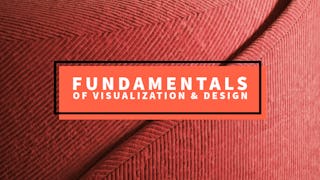In this course, you will analyze and apply essential design principles to your Tableau visualizations. This course assumes you understand the tools within Tableau and have some knowledge of the fundamental concepts of data visualization. You will define and examine the similarities and differences of exploratory and explanatory analysis as well as begin to ask the right questions about what’s needed in a visualization. You will assess how data and design work together, including how to choose the appropriate visual representation for your data, and the difference between effective and ineffective visuals. You will apply effective best practice design principles to your data visualizations and be able to illustrate examples of strategic use of contrast to highlight important elements. You will evaluate pre-attentive attributes and why they are important in visualizations. You will exam the importance of using the "right" amount of color and in the right place and be able to apply design principles to de-clutter your data visualization.

Enjoy unlimited growth with a year of Coursera Plus for $199 (regularly $399). Save now.

Essential Design Principles for Tableau
This course is part of Data Visualization with Tableau Specialization


Instructors: Govind Acharya
83,624 already enrolled
Included with
(2,042 reviews)
Recommended experience
What you'll learn
Examine and improve an ineffective visualization
Examine and improve an ineffective visualization
Apply visualization best practices
Create and design visualizations that work best for the target audience
Skills you'll gain
Details to know

Add to your LinkedIn profile
4 assignments
See how employees at top companies are mastering in-demand skills

Build your subject-matter expertise
- Learn new concepts from industry experts
- Gain a foundational understanding of a subject or tool
- Develop job-relevant skills with hands-on projects
- Earn a shareable career certificate

There are 4 modules in this course
Welcome to this first module where we are going to start you off with background information about how the human brain perceives the world and then you will discover effective and ineffective visuals. By the end of this module, you will be able to recognize how the brain relates to visual design. You will know the difference between cognitive versus perceptual design. You will learn the various visualization options offered by Tableau and some of their advantages and disadvantages. You will discuss how good ethical practices play in designing visualizations. You will also start to examine ineffective visualizations and learn how to improve them.
What's included
9 videos2 readings1 assignment2 discussion prompts
Welcome to this second module. This module will explore specific data visualization concepts that apply the concepts you learned about how the human brain works from the last module. In this module, you will be able to define cognitive load and what clutter means from a visualization perspective. You will be able to visually illustrate the principles of visual perception and use contrast to enhance your visualizations. You will be able to define and use pre-attentive attributes like color to make effective visualizations.
What's included
7 videos1 assignment3 discussion prompts
In this module, we revisit some of the concepts introduced from the previous module. You will be able to apply Gestalt Principles and leverage pre-attentive attributes in your visualizations. You will examine the role of accessibility and aesthetics play in your creations. Also, you will be able to define the ideas of exploratory and explanatory analysis and be able to normalize your data and identify outliers. Finally, you will be introduced to a challenging concept and construct a control chart to set you up to perform more advanced exploratory analysis.
What's included
10 videos2 readings1 assignment2 discussion prompts
Making sense of large, multi-dimensional data sets can be a challenge for anyone. Your task as a designer is to make good decisions about encoding, arranging, and presenting data to reveal meaningful patterns and stories for your audiences. After completing this module, you will be able to design your visualizations for a target audience and with purpose. You will be able to identify the connection to between data, relationships and good visual design. You will implement additional design tools and tips into your visualizations.
What's included
9 videos3 readings1 assignment1 discussion prompt
Earn a career certificate
Add this credential to your LinkedIn profile, resume, or CV. Share it on social media and in your performance review.
Instructors

Offered by
Explore more from Data Analysis
 Status: Free Trial
Status: Free TrialUniversity of Colorado Boulder
 Status: Free Trial
Status: Free TrialUniversity of California, Davis
 Status: Free Trial
Status: Free TrialCorporate Finance Institute
 Status: Preview
Status: PreviewBoard Infinity
Why people choose Coursera for their career




Learner reviews
2,042 reviews
- 5 stars
62.19%
- 4 stars
25.75%
- 3 stars
8.32%
- 2 stars
2%
- 1 star
1.71%
Showing 3 of 2042
Reviewed on Dec 16, 2020
A great course indeed. Learned a lot about Gestalt principles, pre-attentive attributes, knowing your audiences and proper usage of other visual elements.
Reviewed on Jul 30, 2018
Learned a lot about knowing who the audience is (that I am designing a visualization for), also about use-of-color and de-cluttering my visualization.
Reviewed on Apr 18, 2017
I found this course extremely useful as it helped me better understand design principles which can be put into good use in other visualization tools as well.
Frequently asked questions
To access the course materials, assignments and to earn a Certificate, you will need to purchase the Certificate experience when you enroll in a course. You can try a Free Trial instead, or apply for Financial Aid. The course may offer 'Full Course, No Certificate' instead. This option lets you see all course materials, submit required assessments, and get a final grade. This also means that you will not be able to purchase a Certificate experience.
When you enroll in the course, you get access to all of the courses in the Specialization, and you earn a certificate when you complete the work. Your electronic Certificate will be added to your Accomplishments page - from there, you can print your Certificate or add it to your LinkedIn profile.
Yes. In select learning programs, you can apply for financial aid or a scholarship if you can’t afford the enrollment fee. If fin aid or scholarship is available for your learning program selection, you’ll find a link to apply on the description page.
More questions
Financial aid available,





